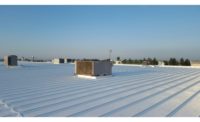Wind Pressure on Low Slope Roofs Monograph Updated

RALEIGH, N.C. — The RCI Foundation’s board of directors has allocated funds for the revision of one its best selling publications entitled Wind Pressure on Low Slope Roofs. This monograph is the work of Stephen Patterson, P.E., R.R.C of Roof Technical Services, Inc. and Madan Mehta, Ph.D., P.E. at the University of Texas at Arlington. The RCI Foundation hopes to roll out the revised publication towards the end of 2012. According to Mehta, “the third edition is keyed to the American Society of Civil Engineers (ASCE) Standard “Minimum Design Loads on Buildings and Other Structures” published in 2010, commonly referred to as ASCE 7-10 Standard. The ASCE 7-10 Standard has been substantially revised from its earlier edition published in 2005 (referred to as ASCE 7-05 Standard). Major changes in ASCE 7-10 Standard that impact the third edition of the Monograph are:
• New strength design level wind speeds instead of the (earlier) service design level wind speeds—a concept that revolutionizes our understanding of the safety provisions inherent in the design of roofing systems for wind resistance.
• Elimination of the Importance Factor—an add-on safety provision used in the earlier editions of the Standard to account for different degrees of risk inherent in buildings. This safety provision has now been absorbed into the wind speed values so that the ASCE 7-10 Standard (and hence the revised Monograph) has three wind speed maps in place of only one wind speed map used previously.
• Description of a (more) precise web-based method of determining wind speed as a function of: (a) the building’s location—latitude and longitude of the site, and (b) the building’s Risk Category (I, II, or III and IV) instead of obtaining the wind speed values from wind speed maps.
• Introduction of (site) Exposure Category D for sites facing large bodies of water (ocean fronts and lakes)
• Changes in wind-borne debris region similar to the earlier editions of the Monograph, its third edition will cover wind pressures on low-slope roofs at three levels of details to suit a diverse body of its readers: a) A theoretical description of the dynamics of wind flow around buildings and its effect on wind pressures on low-slope roofs, b) A step-by-step procedure for determining wind pressures on low-slope roofs followed by numerical examples of how to use the procedure and c) A set of tables from which the values of wind pressures can be simply selected without the use of any procedure or calculations.”
For more information, visit www.rci-online.org.
Looking for a reprint of this article?
From high-res PDFs to custom plaques, order your copy today!






